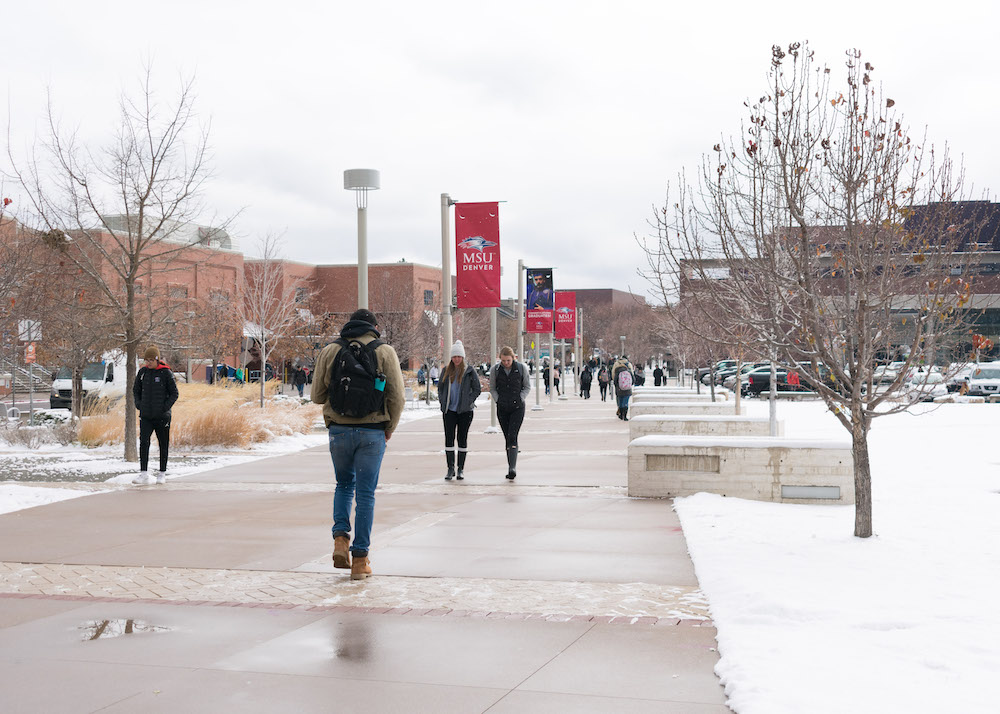

The Budget Recommendation Committee meeting Friday focused on the regular enrollment update, a high-level look at the components of the Metropolitan State University of Denver budget and a look to the future.
The University has seen about a 20% decline in enrollment in the past 10 years from its peak enrollment in 2010-11. The current goal is to maintain enrollment levels that mirror this past fall’s census numbers, totaling 17,466 students with 16,396 undergraduate and 1,070 graduate students. Current projections from MSU Denver’s business-analytics team predict that enrollment will decline by 6%, or 1,048 students, this fall.
Enrollment statistics
- Despite a decline in undergraduate students, the number of graduate students has been steadily increasing since 2011.
- White-student enrollment has been decreasing while Hispanic-student enrollment has increased.
- Black-student enrollment has remained steady.
- Male-student enrollment has slightly decreased as female enrollment has slightly increased.
- First-generation students have continued increasing and make up 56% of MSU Denver’s student population.
- Enrollment of students ages 20-24 has declined by more than 2,000 in the past decade.
- There has been slight growth in students who receive low contribution from FAFSA, while about 30% of students do not submit FAFSA.
- Undeclared students are less likely to be retained.
Enrollment next steps
The University will continue to:
- Monitor race, ethnicity and gender enrollment trends across programs; benchmark against other institutions; monitor feeder public-school demographics; and monitor outcomes.
- Maximize funding for best-in-class supports for first-generation students.
- Identify key issues impacting the college choices of students ages 20-24 and conduct a housing study.
- Examine what groups are not filing FAFSA to provide more support; and work with school districts and examine policy to increase FAFSA completion in high school students.
Goals
- Retain 700 students in the next three years.
- Institutionalize early interventions.
- Examine new strategies and identify what MSU Denver should stop doing.
- Identify effective retention strategies and increase funding where students could be served.
- Identify gaps (students with disabilities, students who are parenting, justice-involved students, etc.).
Budget 101
Members also took a comprehensive look at the components of the University’s budget, including sources of revenue, budget allocations, historical and comparative information, challenges, enrollment and the future outlook.
Operating budget components
MSU Denver is funded primarily through tuition revenue, state support, program fees and indirect cost recoveries. Additionally, the operating budget is fed by auxiliaries such as mandatory student fees, graduate programs and other cash-funded programs as well as business activities such as the Health Center at Auraria.
Tuition and fees make up the largest portion of the fiscal 2021-22 budget at just over $153.4 million, followed by $72.5 million in state support and nearly $21.5 from the other sources listed above for a total operating budget of nearly $247.5 million.
Faculty compensation is the University’s largest allocation at nearly $85.2 million, followed by professional-staff compensation ($57.3 million) and nonlabor operating expenses ($54.5 million). The University also contributes $12.2 million to the Auraria Higher Education Center budget, dedicates $9.2 million to scholarships and allots $8.2 million to classified-staff compensation. Other expenses include student- and hourly employee compensation ($5.9 million), support for the Auraria Library ($5.3 million) and executive-leadership compensation ($4 million).
The presentation also outlined how Colorado has shifted higher-education funding from the state to the student. Students’ share of college tuition increased from around 32% in 2000 to nearly 68% in 2019. Although efforts have been made to increase state funding, Colorado is still ranked 48th in the country for funding per full-time-equivalent student. MSU Denver students receive the second-lowest level of state support at just over $6,000 per FTE student but had remained the lowest-funded institution in the state for more than decade. While the University has relied more heavily on tuition revenue, it has also consistently been the most affordable university in metro Denver. Simultaneously, MSU Denver has grappled with the most significant staff gap. As of 2020, the University’s student-to-employee ratio was 24:1, compared with the University of Colorado Denver’s 2.3:1
However, enrollment remains the University’s main challenge, as declines since the peak enrollment in 2010-11 have resulted in a cumulative financial loss of $242 million (had 2010-11 enrollment levels continued through 2021-22).
Future focus
As previously outlined, guidance from the Office of the President and the Office of Strategy is to focus on recovery through upgrades and one-time investments, enrollment stabilization and building toward fiscal 2024 and beyond. Branches and departments have been asked to share their key goals for fiscal 2023, ensuring that those goals are aligned with the 2030 Strategic Plan, prior to the next BRC meeting Friday. Follow the Early Bird for updates and recaps.

